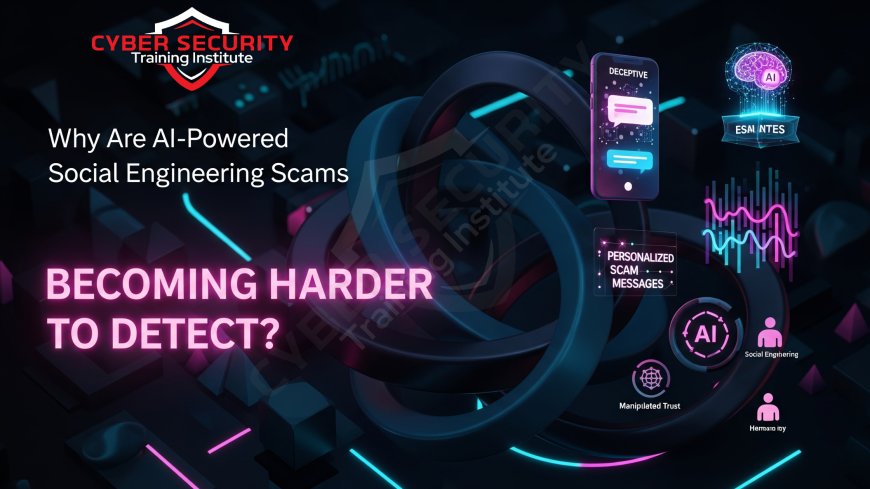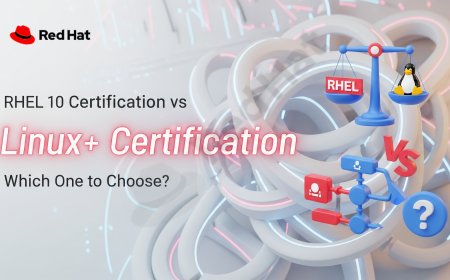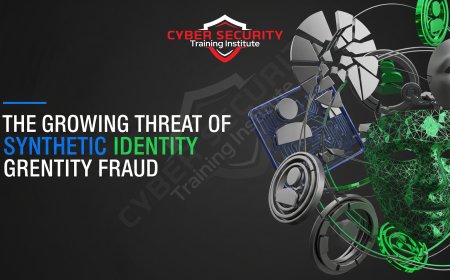Why Are AI-Powered Social Engineering Scams Becoming Harder to Detect?
Artificial Intelligence is fueling a new generation of hyper-realistic social engineering scams that are becoming nearly impossible for humans to detect. This in-depth article, written from the perspective of 2025, reveals why these AI-powered attacks are so effective. We break down the key tactics cybercriminals are now using: AI-driven reconnaissance for deep personalization, generative AI for creating linguistically perfect and context-aware messages that eliminate the classic red flags, and the use of multi-modal attacks that combine flawless emails with convincing, real-time deepfake voice calls. The piece features a comparative analysis of traditional versus AI-powered social engineering, highlighting the alarming evolution in quality, scale, and believability. We also provide a focused case study on how these sophisticated scams are being used to target the large pool of new tech professionals in Pune, India. This is an essential read for anyone looking to understand the modern threat landscape, why old security training is now obsolete, and why a "Zero Trust" mindset combined with new, AI-powered defenses is the only path forward.

Introduction: The End of the Obvious Scam
For years, we've been taught a simple set of rules to spot a scam: look for the bad grammar, the awkward phrasing, the generic greeting like "Dear Valued Customer." That training, which served us well for a decade, is now dangerously obsolete. Here in 2025, Generative AI has armed social engineers with a toolkit that erases these classic red flags, making their attacks blend in seamlessly with our daily flood of legitimate digital communications. AI isn't just making old scams better; it's creating a new category of deception that is personalized, contextually aware, and multi-layered. AI-powered social engineering is becoming incredibly hard to detect because it systematically dismantles the human intuition we've come to rely on, crafting perfect lures that feel expected, legitimate, and trustworthy.
The Power of a Name: AI-Driven Hyper-Personalization
The first and most powerful weapon that AI gives to a scammer is personalization at scale. In the past, attackers had to choose between a low-quality, generic phishing email sent to millions, or a high-quality, manually researched "spear-phishing" email for a single high-value target. AI has erased this trade-off.
Modern scam campaigns begin with an AI tool that automates reconnaissance. It can scrape a target's entire digital footprint in seconds—their LinkedIn profile detailing their job history and colleagues, their social media posts about recent activities, and company press releases mentioning their projects. The AI then synthesizes this data to create a "hyper-personalized" lure. The email you receive is no longer a generic alert. Instead, it might be:
"Hi Priya, it was great connecting at the NASSCOM event in Mumbai last month. I was thinking about your comments on supply chain logistics and found an article I thought you'd find interesting. Here's the link."
This message is specific, it references a real event and a real professional interest, and it uses a casual, friendly tone. It bypasses our internal "scam filter" because it feels like a genuine, human interaction, making the recipient far more likely to click the malicious link.
Perfect Prose: Flawless Language and Contextual Awareness
The most obvious giveaway of a classic phishing attempt was its poor language. Awkward grammar, spelling mistakes, and strange phrasing were dead giveaways that the message was not from a legitimate source. Generative AI has completely eliminated this red flag. AI models can now produce text that is not just grammatically perfect, but stylistically flawless. They can mimic the formal, jargon-filled tone of a corporate legal department, the brief and urgent style of a CEO's email, or the casual, emoji-filled text of a coworker.
Beyond simple grammar, these models possess contextual awareness. An AI can craft an email impersonating an IT department that references a *real*, ongoing system migration that was mentioned in a recent company-wide email. This creates a powerful sense of legitimacy and continuity. The scam no longer feels like a random, out-of-the-blue event, but rather a logical next step in a known process, making the user far less likely to question its authenticity. .
More Than Words: The Rise of Multi-Modal Deepfake Attacks
Perhaps the most alarming development in 2025 is that social engineering is no longer confined to text. AI allows attackers to launch multi-modal attacks, layering different forms of communication to make their scams even more convincing.
- Deepfake Voice (Vishing): This is the most common and effective escalation. An attacker can follow up a perfectly crafted phishing email with a phone call that uses a real-time, AI-cloned voice of the supposed sender. Imagine receiving an urgent payment request email from your CFO, and a minute later, your phone rings. You hear your CFO's exact voice saying, "Hi, just checking you got my email. We need to get that processed in the next 10 minutes, please." The combination of the official-looking email and the trusted, familiar voice is often enough to overwhelm any lingering suspicion.
- Emerging Deepfake Video: While still computationally expensive for mass campaigns, targeted deepfake video is a growing threat. An attacker might use this in a final-stage attack to secure a multi-crore wire transfer. A finance employee might receive an urgent request, and when they hesitate, they get a brief, one-way video call on Microsoft Teams. They see their CEO's face, who says, "I approve this payment," before the connection conveniently drops. That fleeting visual confirmation is often all it takes to bypass final security checks.
Comparative Analysis: Traditional vs. AI-Powered Social Engineering
AI has fundamentally upgraded every aspect of the social engineering playbook, making old defensive training and instincts unreliable.
| Tactic | Traditional Scam | AI-Powered Scam (2025) |
|---|---|---|
| Personalization | Used generic greetings ("Dear User") or a simple mail-merge with the target's first name. | Employs hyper-personalization, referencing the target's specific job role, recent public activities, and professional connections. |
| Language & Tone | Often contained obvious grammatical errors, spelling mistakes, and awkward, non-native phrasing. | Is linguistically perfect and context-aware. The AI can flawlessly mimic specific corporate, legal, or casual communication styles. |
| Attack Medium | Was almost exclusively text-based, relying on email, SMS, or instant messages. | Is often multi-modal, layering a convincing email with a real-time, deepfake voice or video call to increase pressure and legitimacy. |
| Scale vs. Quality | Attackers had to choose between quality (a slow, manual spear-phishing attack) and quantity (a low-quality, mass-phishing campaign). | Achieves both quality and quantity simultaneously. An AI can generate thousands of unique, high-quality spear-phishing attacks automatically. |
| Primary "Tell" | Relied on the victim missing obvious red flags and inconsistencies in the message. | Systematically eliminates the human "tells", bypassing intuition and making the fraudulent request feel entirely legitimate and expected. |
Targeting Pune's Fresh and Eager Talent Pool
Pune's status as a major educational center and a primary destination for the IT and BPO industries means it has a massive and constantly refreshing pool of young professionals. This demographic, while digitally native, is also uniquely vulnerable to AI-powered social engineering. New hires are often eager to please, unfamiliar with the specific communication patterns of their new employer, and highly susceptible to authority bias.
In 2025, we are seeing attackers use AI to specifically target this group. An AI can easily scan LinkedIn to identify individuals who have updated their profiles to show they started a new job at a large tech company in Hinjawadi or a BPO in Kharadi within the last month. The system then crafts a sophisticated attack. For example, a new hire receives a call from a perfect, AI-cloned voice of their new "HR Manager." The voice is friendly and official: "Welcome to the team, Rohan! This is Priya from HR. We're just finalizing your payroll enrollment and need you to log into this temporary portal to confirm your bank details. I've sent the link to your personal email to get this sorted before your first salary is paid." A new employee, not wanting to make a mistake or cause trouble in their first few weeks, is far more likely to comply with this urgent and seemingly helpful request than a long-tenured employee who is more familiar with company procedures.
Conclusion: A New Mindset for a New Threat
AI-powered social engineering is becoming harder to detect because it skillfully combines the scale of automation with the nuance of human personalization and psychology. The attacks are text-perfect, contextually relevant, and layered with believable deepfakes, systematically eroding our ability to spot the fraud. The old advice of "look for the spelling mistakes" is now useless. Our defense must therefore evolve from simple pattern matching to a more robust, procedural, and skeptical mindset.
This means embracing a "Zero Trust" approach to communication: never trust a sensitive request that comes through a single channel, no matter how authentic it seems. It requires organizations to enforce rigid, multi-channel verification procedures for actions like payments or data access. And it means deploying a new generation of AI-powered security tools that can analyze communication patterns to spot the subtle behavioral anomalies that are the new red flags. The human brain is now the primary target of malicious AI; our defense must be a combination of smarter procedures and even smarter technology.
Frequently Asked Questions
What is social engineering?
Social engineering is the psychological manipulation of people into performing actions or divulging confidential information. It's the art of the "human hack."
What is a deepfake?
A deepfake is a synthetic piece of media, like a video or audio clip, where a person's likeness or voice has been replaced or generated by an AI to create something that appears real but is actually fake.
How can an AI personalize a scam email so well?
By automatically scraping public data from sources like LinkedIn, social media, and company news. It then uses this data to reference a target's real job, colleagues, and recent activities to make the email seem highly relevant.
What is a "multi-modal" attack?
A multi-modal attack uses more than one type of communication. For example, an attacker might send a convincing email and then follow up with a deepfake voice call to make the scam more believable.
Is it still possible to spot a phishing email in 2025?
Yes, but you can no longer rely on spotting bad grammar. Instead, you must focus on the context of the request. Is it unusual? Does it ask you to bypass a normal procedure? Does it have a sense of extreme urgency? These are the new red flags.
What is Business Email Compromise (BEC)?
BEC is a type of scam where an attacker uses a compromised or spoofed email account of a company executive to trick an employee into making an unauthorized wire transfer. AI has made these attacks text-perfect.
Why are new hires in a city like Pune a prime target?
Because they are often unfamiliar with their new company's specific security procedures and are eager to be helpful. This makes them more likely to trust an urgent-sounding request from someone they believe is a superior or from HR.
What is a "Zero Trust" mindset in this context?
It means not automatically trusting any digital communication, even if it appears to be from a known source. It's about verifying sensitive requests through a separate, trusted channel before taking action (e.g., getting an email and then confirming via a direct message on a company app).
How can companies defend against this?
Through a combination of employee training focused on these new, sophisticated tactics and by implementing AI-powered email security solutions that analyze communication patterns and behavior to detect anomalies, rather than just looking for bad links.
Is my personal email account also at risk?
Absolutely. Attackers can use the same techniques to target individuals, scraping your social media to create personalized scams related to your hobbies, recent travel, or family members.
What is a "payload-less" attack?
This is an attack, like a BEC scam, that doesn't contain a malicious file or link (a "payload"). The email's text itself is the weapon, designed to trick the recipient into taking an action in the real world.
How is Generative AI different from other types of AI?
Generative AI is a category of AI that can create new, original content, such as text, images, or audio. This is different from analytical AI, which is primarily used to analyze and find patterns in existing data.
Can AI also be used to detect these scams?
Yes. The leading defense against these attacks is a new generation of security tools that use their own AI to analyze the context and metadata of communications to spot anomalies that a human might miss. It's an AI-vs-AI battle.
What is "vishing"?
Vishing stands for "voice phishing." It is a phishing attack that is conducted over the phone, using a voice call. Deepfake technology has made vishing far more dangerous.
How can I verify a suspicious request?
Use an "out-of-band" method. If you get a suspicious email from your boss, don't reply to the email. Instead, call them on their known phone number or send them a direct message on a trusted platform like Microsoft Teams or Slack to confirm.
Are there any tools to detect deepfake voices?
Yes, there are emerging technologies that can analyze audio for the subtle artificial artifacts left by AI generation. However, these are not yet widely available to the public and are in a constant arms race with the improving quality of deepfakes.
What does it mean for an attack to be "at scale"?
It means the ability to launch the attack against a very large number of targets simultaneously. AI allows high-quality, personalized attacks to be launched "at scale," which was previously not possible.
Why is it called "social" engineering?
Because it targets human psychology—our tendencies to trust, to be helpful, to respond to authority, and to react under pressure—rather than targeting a technical vulnerability in software.
Is there any single red flag to look for anymore?
The most reliable red flag in 2025 is urgency combined with a request to bypass a standard procedure. Any message that says "this is extremely urgent, and you must not follow the normal rules" should be treated as a potential attack.
What is the future of social engineering?
The future will likely involve even more sophisticated, fully automated, multi-modal scams. Imagine an AI that sends a personalized email, follows up with a deepfake voice call, and then engages the victim in a real-time, AI-driven chat session to guide them through the scam.
What's Your Reaction?
 Like
0
Like
0
 Dislike
0
Dislike
0
 Love
0
Love
0
 Funny
0
Funny
0
 Angry
0
Angry
0
 Sad
0
Sad
0
 Wow
0
Wow
0

















